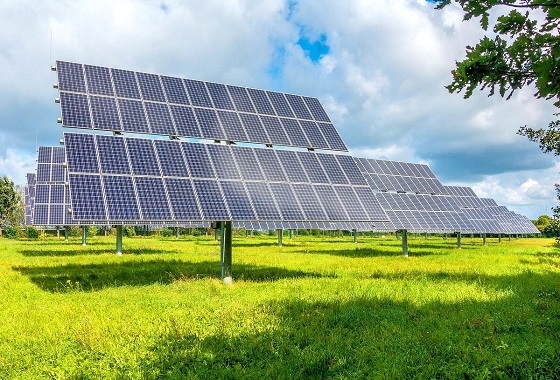Economy
Not energy ‘transition’ but energy ‘addition’. Intermittent wind and sun requires backup power generation

From Resource Works
Until battery technology is an option, there is no real energy transition
Climate campaigners steadily push for clean, renewable energy sources to replace hydrocarbons. However, international consultants Wood Mackenzie view this push as overly simplistic, arguing it does not consider the complexities of energy supply and the uses of oil and gas that extend far beyond power generation.
“Perhaps most striking is the extraordinary contribution that oil and gas have made to energy supply and what a gargantuan task it will be to build a new low-carbon system in its place.”
The latest report from “WoodMac” lists several challenges for a future of low-carbon power.
For one, U.S. demand for electrical power is set to grow at least through the rest of this decade.
“What is exciting about this new growth is that it is a manifestation of the Fourth Industrial Revolution. Central to this is the explosive growth of data centres, the beating heart of the infrastructure supporting artificial intelligence (AI), cloud computing, digitalization, and big data. Second is a new wave of cleantech, including the manufacturing of semiconductors, batteries, and renewable energy equipment. Third is the increasing electrification of the economy.”
Offshore wind’s power output has an energy efficiency of 92% compared with oil and gas, which, in use, deliver only 25% of their original energy content. But “what may impress is how long it will take for the cumulative output of wind to exceed that of oil and gas, despite this disparity in energy efficiency.”
Closer to home, questions have been raised in Canada about climate campaigners’ arguments that the costs of solar and wind power operations have steadily decreased and are now comparatively affordable.
The small-c conservative Fraser Institute notes that the G7 countries (including Canada) have pledged to triple renewable energy sources to ensure an “affordable” energy future.
“But while direct costs for wind and solar are dropping, they remain expensive due in part to the backup energy sources required when renewables are not available.
“Wind and solar energy are intermittent, meaning they aren’t consistently available, so we need an alternative power source when there’s no sunlight or wind, given the current limited ability to store energy from solar and wind.
“So we must maintain enough energy capacity in a parallel system, typically powered by natural gas. Constructing and maintaining a secondary energy source results in higher overall energy costs because two energy systems cost more than one. Therefore, when evaluating the costs of renewables, we must consider the costs of backup energy.
“Often, when proponents claim that wind and solar sources are cheaper than fossil fuels, they ignore these costs.”
The TD Bank adds: “Despite the improvement in the cost-competitiveness of renewable and storage technologies, the growth of low-carbon electricity supply is likely to increase electricity costs.
“According to estimates by the Alberta Electric System Operator, the load-adjusted generation costs in 2035 could be 56–66% higher in net-zero-by-2035 scenarios compared to a technology trajectory based on current policies.
“For Ontario, we estimate that replacing expiring gas-generator contracts with a combination of solar, wind, storage, and small modular reactors could increase the average generation cost by around 20% in 2035 compared to what it would be if the gas contracts were renewed and the current procurement plan for new resources proceeds as planned.”
The Fraser Institute also cites a 2021 study by University of Chicago economists showing that between 1990 and 2015, U.S. states that mandated minimum renewable power sources experienced significant electricity price increases after accounting for backup infrastructure and other costs.
“Specifically, in those states, electricity prices increased by an average of 11 per cent, costing consumers an additional $30 billion annually. The study also found that electricity prices grew more expensive over time, and by the twelfth year, electricity prices were 17 per cent higher (on average).”
“Europe is another case in point. Between 2006 and 2019, solar and wind sources went from representing around 5 per cent of Germany’s electricity generation to almost 30 per cent in 2019. During that same period, German households experienced an increase in electricity prices from 19.46 cents to 30.46 cents per kilowatt hour — a rise of more than 56 per cent. This surge in prices occurred before the war in Ukraine, which led to an unprecedented price spike in 2022.”
Meanwhile, in the U.S., a study published in Energy, a peer-reviewed energy and engineering journal, found that — after accounting for backup, energy storage, and associated indirect costs — solar power costs skyrocket from US$36 per megawatt hour (MWh) to as high as US$1,548, and wind generation costs increase from US$40 to up to US$504 per MWh.
We’re firmly in favour of advancing renewable energy sources, and the sooner, the better. But the cost estimates need to be true
Automotive
Federal government should swiftly axe foolish EV mandate

From the Fraser Institute
Two recent events exemplify the fundamental irrationality that is Canada’s electric vehicle (EV) policy.
First, the Carney government re-committed to Justin Trudeau’s EV transition mandate that by 2035 all (that’s 100 per cent) of new car sales in Canada consist of “zero emission vehicles” including battery EVs, plug-in hybrid EVs and fuel-cell powered vehicles (which are virtually non-existent in today’s market). This policy has been a foolish idea since inception. The mass of car-buyers in Canada showed little desire to buy them in 2022, when the government announced the plan, and they still don’t want them.
Second, President Trump’s “Big Beautiful” budget bill has slashed taxpayer subsidies for buying new and used EVs, ended federal support for EV charging stations, and limited the ability of states to use fuel standards to force EVs onto the sales lot. Of course, Canada should not craft policy to simply match U.S. policy, but in light of policy changes south of the border Canadian policymakers would be wise to give their own EV policies a rethink.
And in this case, a rethink—that is, scrapping Ottawa’s mandate—would only benefit most Canadians. Indeed, most Canadians disapprove of the mandate; most do not want to buy EVs; most can’t afford to buy EVs (which are more expensive than traditional internal combustion vehicles and more expensive to insure and repair); and if they do manage to swing the cost of an EV, most will likely find it difficult to find public charging stations.
Also, consider this. Globally, the mining sector likely lacks the ability to keep up with the supply of metals needed to produce EVs and satisfy government mandates like we have in Canada, potentially further driving up production costs and ultimately sticker prices.
Finally, if you’re worried about losing the climate and environmental benefits of an EV transition, you should, well, not worry that much. The benefits of vehicle electrification for climate/environmental risk reduction have been oversold. In some circumstances EVs can help reduce GHG emissions—in others, they can make them worse. It depends on the fuel used to generate electricity used to charge them. And EVs have environmental negatives of their own—their fancy tires cause a lot of fine particulate pollution, one of the more harmful types of air pollution that can affect our health. And when they burst into flames (which they do with disturbing regularity) they spew toxic metals and plastics into the air with abandon.
So, to sum up in point form. Prime Minister Carney’s government has re-upped its commitment to the Trudeau-era 2035 EV mandate even while Canadians have shown for years that most don’t want to buy them. EVs don’t provide meaningful environmental benefits. They represent the worst of public policy (picking winning or losing technologies in mass markets). They are unjust (tax-robbing people who can’t afford them to subsidize those who can). And taxpayer-funded “investments” in EVs and EV-battery technology will likely be wasted in light of the diminishing U.S. market for Canadian EV tech.
If ever there was a policy so justifiably axed on its failed merits, it’s Ottawa’s EV mandate. Hopefully, the pragmatists we’ve heard much about since Carney’s election victory will acknowledge EV reality.
Economy
The stars are aligning for a new pipeline to the West Coast

From Resource Works
Mark Carney says another pipeline is “highly likely”, and that welcome news.
While attending this year’s Calgary Stampede, Prime Minister Mark Carney made it official that a new pipeline to Canada’s West Coast is “highly likely.”
While far from a guarantee, it is still great news for Canada and our energy industry. After years of projects being put on hold or cancelled, things are coming together at the perfect time for truly nation-building enterprises.
Carney’s comments at Stampede have been preceded by a number of other promising signs.
At a June meeting between Carney and the premiers in Saskatoon, Alberta Premier Danielle Smith proposed a “grand bargain” that would include a privately funded pipeline capable of moving a million barrels of oil a day, along with significant green investments.
Carney agreed with Smith’s plan, saying that Canada needed to balance economic growth with environmental responsibility.
Business and political leaders have been mostly united in calling for the federal government to speed up the building of pipelines, for economic and strategic reasons. As we know, it is very difficult to find consensus in Canada, with British Columbia Premier David Eby still reluctant to commit to another pipeline on the coast of the province.
Alberta has been actively encouraging support from the private sector to fund a new pipeline that would fulfil the goals of the Northern Gateway project, a pipeline proposed in 2008 but snuffed out by a hail of regulations under former Prime Minister Justin Trudeau.
We are in a new era, however, and we at Resource Works remarked that last month’s G7 meeting in Kananaskis could prove to be a pivotal moment in the history of Canadian energy. An Ipsos poll found that Canada was the most favoured nation for supplying oil in the G7, and our potential as an energy superpower has never been more important for the democratic world, given the instability caused by Russia and other autocratic energy powers.
Because of this shifting, uncertain global climate, Canadian oil and gas are more attractive than ever, and diversifying our exports beyond the United States has become a necessity in the wake of Donald Trump’s regime of tariffs on Canada and other friendly countries.
It has jolted Canadian political leaders into action, and the premiers are all on board with strengthening our economic independence and trade diversification, even if not all agree on what that should look like.
Two premiers who have found common ground are Danielle Smith and Ontario Premier Doug Ford. After meeting at Stampede, the pair signed two memorandums of understanding to collaborate on studying an energy corridor and other infrastructure to boost interprovincial trade. This included the possibility of an eastward-bound pipeline to Ontario ports for shipping abroad.
Ford explicitly said that “the days of relying on the United States 100 percent, those days are over.” That’s in line with Alberta’s push for new pipeline routes, especially to northwestern B.C., which are supported by Smith’s government.
On June 10, Resource Works founder and CEO Stewart Muir wrote that Canadian energy projects are a daunting endeavour, akin to a complicated jigsaw puzzle, but that getting discouraged by the complexity causes us to lose sight of the picture itself. He asserted that Canadians have to accept that messiness, not avoid it.
Prime Minister Carney has suggested he will make adjustments to existing regulations and controversial legislation like Bill C-69 and the emissions cap, all of which have slowed the development of new energy infrastructure.
This moment of alignment between Ottawa, the provinces, and other stakeholders cannot be wasted. The stars are aligning, and it will be a tragedy if we cannot take a great step into the future of our country.
-

 International2 days ago
International2 days agoChicago suburb purchases childhood home of Pope Leo XIV
-

 Daily Caller2 days ago
Daily Caller2 days agoBlackouts Coming If America Continues With Biden-Era Green Frenzy, Trump Admin Warns
-

 Daily Caller2 days ago
Daily Caller2 days ago‘I Know How These People Operate’: Fmr CIA Officer Calls BS On FBI’s New Epstein Intel
-

 Frontier Centre for Public Policy1 day ago
Frontier Centre for Public Policy1 day agoNew Book Warns The Decline In Marriage Comes At A High Cost
-

 Economy1 day ago
Economy1 day agoThe stars are aligning for a new pipeline to the West Coast
-

 National1 day ago
National1 day agoLiberal ‘Project Fear’ A Longer Con
-

 Censorship Industrial Complex22 hours ago
Censorship Industrial Complex22 hours agoCanadian pro-freedom group sounds alarm over Liberal plans to revive internet censorship bill
-

 Crime22 hours ago
Crime22 hours agoTrump supporters cry foul after DOJ memo buries the Epstein sex trafficking scandal







